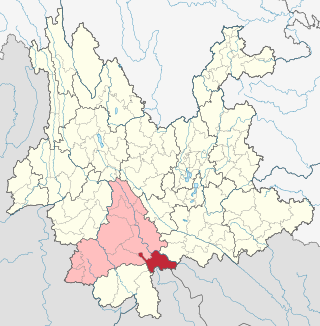
The Dai people are several Tai-speaking ethnic groups living in the Xishuangbanna Dai Autonomous Prefecture and the Dehong Dai and Jingpo Autonomous Prefecture of China's Yunnan Province. The Dai people form one of the 56 ethnic groups officially recognized by the People's Republic of China. By extension, the term can apply to groups in Laos, Vietnam, Thailand and Myanmar when Dai is used to mean specifically Tai Yai, Lue, Chinese Shan, Tai Dam, Tai Khao or even Tai in general. For other names, see the table below.

The Bulang people are an ethnic group. They form one of the 56 ethnic groups officially recognized by the People's Republic of China.

Jinghong is a city in and the seat of Xishuangbanna Dai Autonomous Prefecture, in the far south of China's Yunnan province, and the historic capital of the former Tai kingdom of Sipsongpanna.
Tai Lue or Xishuangbanna Dai is a Tai language of the Lu people, spoken by about 700,000 people in Southeast Asia. This includes 280,000 people in China (Yunnan), 200,000 in Burma, 134,000 in Laos, 83,000 in Thailand and 4,960 in Vietnam. The language is similar to other Tai languages and is closely related to Kham Mueang or Tai Yuan, which is also known as Northern Thai language. In Yunnan, it is spoken in all of Xishuangbanna Dai Autonomous Prefecture, as well as Jiangcheng Hani and Yi Autonomous County in Pu'er City.

The Dehong Dai and Jingpo Autonomous Prefecture is an autonomous prefecture in western Yunnan province, China. It is bordered by Baoshan to the east and Myanmar's Kachin State to the west. Its titular ethnic minorities are the Dai and Jingpo, who make up 28 and 11 percent of the prefecture's population, respectively.
Akha is the language spoken by the Akha people of southern China, eastern Burma, northern Laos, and northern Thailand.
Bit is an Austroasiatic language spoken by around 2,000 people in Phongsaly Province, northern Laos and in Mengla County, Yunnan, China.

Jiangcheng Hani and Yi Autonomous County is an autonomous county under the jurisdiction of Pu'er City, in southern Yunnan, China, bordering Laos and Vietnam to the south, making it the only county in the province to border more than one country. By road, its seat, the town of Menglie (勐烈镇), is 520 km (320 mi) from Kunming and 145 km (90 mi) from Simao District, the municipal seat of Pu'er.

Jinggu Dai and Yi Autonomous County is an autonomous county under the jurisdiction of Pu'er City, Yunnan Province, China.

Menghai County is a county under the jurisdiction of Xishuangbanna Dai Autonomous Prefecture, in the far south of Yunnan, China, bordering Burma's Shan State to the southwest. Meng is as variation of Mueang.

Mengla County is a county under the jurisdiction of the Xishuangbanna Dai Autonomous Prefecture, in far southern Yunnan province, China. Meng is a variation of Mueang.

Chiang Hung, Sipsongpanna or Keng Hung was one of the states of Shans under the suzerainty of Burma and China.
Tai Ya, also known as Tai Cung, Tai Chung and Dai Ya, is a Southwestern Tai language of southern China. It has one dialect, Tai Hongjin ; Red Tai.
Hu, also Angku or Kon Keu, is a Palaungic language of Xishuangbanna Dai Autonomous Prefecture, Yunnan, China. Its speakers are an unclassified ethnic minority; the Chinese government counts the Angku as members of the Bulang nationality, but the Angku language is not intelligible with Bulang.
Sangkong is a Loloish language spoken in China by the Hani people in Xiaojie Township 小街乡, Jinghong County. They are called Buxia (布夏) by the local Dai people.
Akeu is a Loloish language mainly spoken in Jinghong and Mengla County, China, with smaller populations of speakers in Burma, Laos, and Thailand. Gokhy may be related.
Chao Mom Kham Lue, Chinese name Dao Shixun was the last native chief of Sipsongpanna, and a professor of linguistics. He was born Jinghong. He was the 28th Chao Phaen Din.
Mange Temple is a Buddhist temple located in Jinghong of Xishuangbanna Dai Autonomous Prefecture, Yunnan, China. Covering an area of 1,300-square-metre (0.32-acre), the temple is bordered by Lancang River in the north. Built in 1477, the temple is one of the oldest temples in Xishuangbanna Dai Autonomous Prefecture.
Gasa is a town located in the southwest part of Jinghong, Xishuangbanna Dai Autonomous Prefecture.














